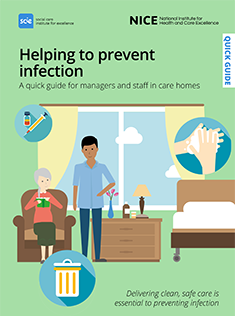A quick guide for managers and staff in care homes
For people living in care homes, infections can be serious, and in some cases, life-threatening.
They can also make existing medical conditions worse. Regular contact with staff, other residents, family and friends and the shared living space all mean infection can easily be passed around. It is therefore vital to take the steps that can help prevent infection occurring.
Delivering clean, safe care is essential to preventing infection.
Hand decontamination
Having clean hands is the most effective way of preventing infection from spreading. There are 5 important moments when you should clean your hands:
- just before you provide care to a resident
- as soon as you have finished providing care to a resident
- straight after you have been exposed to any body fluids
- straight after touching the person's surroundings (such as chair, door handle) if this may have contaminated your hands
- as soon as you take off protective gloves.
Adapted from 'My 5 Moments for Hand Hygiene' - World Health Organisation.
To make it easier to wash your hands regularly, you should:
- keep your arms bare below the elbow
- remove wrist and hand jewellery before starting work
- have short, clean fingernails without nail polish or false nails
- cover cuts or grazes with a waterproof dressing.
Decontaminate your hands with a handrub, except in the following situations when liquid soap and water should be used:
- when your hands are clearly dirty or may be contaminated with body fluids
- when you have been providing care to residents with vomiting or diarrhoea, even if you have been wearing gloves.
The World Health Organization provides an example diagram showing how to effectively wash your hands or use handrub.

Personal protective equipment
This includes the use of gloves and aprons to protect you and reduce the risk of infection while providing care. Selecting which protective equipment to use will require an assessment of the task and the risk to both yourself and the resident.
- wear each item only once
- if gloves are needed, put them on just before providing care and take them off straight afterwards
- change gloves between different care tasks for one person, for example, personal care and care that involves non-intact skin
- change gloves between care tasks for different people
- dispose of all used items correctly.
Sharps
This refers mainly to the use of needles for which staff will need to have the right training and skills. To help prevent infection:
- handle sharps as little as possible and don't pass them from hand to hand
- do not bend, break or recap a used needle
- put used sharps in the right container straight away
- don't use sharps containers for anything else
- dispose of sharps containers when the fill line is reached.
Waste disposal
Healthcare waste, such as dressings and disposable clothing, can spread infection. To reduce the risk of this:
- put waste immediately into the right colour storage, bag or container
- make sure you know how healthcare waste must be labelled and stored
- make sure residents and their friends and family understand how waste must be handled, stored and disposed of.
Education
Residents and their friends and family can play a part in helping to prevent infection. Make sure they know about:
- the importance of clean hands
- how, when and where to clean their hands
- when to use handrub or soap and water
- what they can do to make sure care staff maintain clean hands.

Useful links
- NICE guideline: Healthcare-associated infections: prevention and control in primary and community care (CG139)
- NICE quality standard: Infection prevention and control (QS61).
The guideline and quality standard have been developed to complement the Department of Health's code of practice on the prevention and control of infections. The code of practice and accompanying information resource cover a range of additional valuable information for managers and staff in care homes, including:
- hygiene measures of staff, visitors and residents with respiratory infections
- when and how long to exclude staff from work when they have an infection or they have come into contact with an infection in their own home
- assessing the need for isolation of residents because of infectious disease.
- Department of Health: Code of practice on the prevention and control of infections
- Department of Health/Public Health England: Care homes: infection prevention and control - an information resource
- University Hospitals, Birmingham NHS Foundation Trust: Infection control: break the chain (YouTube)
- Care Quality Commission: Residential adult social care: information for providers
- Royal College of Nursing: Essential practice for infection prevention and control.

Download this guide
We've created a copy of this guide that you can print and share:
This content has been co-produced by NICE and the Social Care Institute for Excellence (SCIE). It is based on NICE’s guideline on healthcare associated infections: prevention and control in primary and community care and quality standard on infection prevention and control.